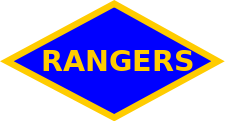6th Ranger Battalion (United States)
| 6th Ranger Battalion | |
|---|---|
|
shoulder sleeve patch of the Ranger Battalions | |
| Active | 1942–1945 |
| Country | United States of America |
| Branch | United States Army |
| Type | Special operations and Light infantry |
| Size | Battalion |
| Engagements | |
| Commanders | |
| Notable commanders |
Lt. Col. Callicut Henry Mucci |
The 6th Ranger Battalion was a United States Army Ranger Battalion which saw action in the Pacific during World War II. The battalion is best known for its role in the Raid at Cabanatuan in the Philippines in January 1945.
98th Field Artillery Battalion
The 6th Rangers history begins with a mule-drawn pack artillery unit, the 98th Field Artillery Battalion. The 98th Field Artillery was formed at Camp Carson, Colorado in 1942 under the command of Lieutenant Colonel Callicut. In December 1942, the battalion embarked for Brisbane, Australia, but due to Australian animal importation laws, the Battalion was redirected to New Guinea, arriving at Port Moresby on 17 February 1943.
The Battalion spent the next 12 months in training, but saw no combat. In February 1943, US Sixth Army decided that the battalion was obsolete, and removed the unit's 800 mules, as well as its commander, who was transferred to the 1st Cavalry Division. The battalion's new commander was Lieutenant Colonel Henry A. Mucci.
Ranger training
Mucci had led a training camp in Hawaii which used Ranger training techniques. He announced that the Battalion was being converted from Field Artillery to Rangers, and downsized from 1,000 men to only 500. Some of the artillery officers were transferred out and replaced by Infantry and Engineer officers.
The task of conversion and training took over a year, but by July 1944 it was completed. The battalion was transferred to Finschhafen, New Guinea, where it was reorganised as a Ranger Battalion and redesignated as the 6th Ranger Battalion.
Philippine campaign
The 6th Rangers were to lead the invasion of the Philippines. The battalion left Finchhaven for Leyte in the Philippines on 10 October 1944. It was to secure the islands of Dinagat, Homonhon and Suluan, located in the entrance to the Leyte Gulf. These islands had the potential to disrupt 6th Army's landing operations if they remained in Japanese hands. After initial delays due to bad weather, the operation went ahead on 18 October, and was a success. The 6th Rangers on Dinagat raised the first American flag on Philippine soil as part of General Douglas MacArthur's 'Return to the Philippines'.
After the success of this mission, the Invasion of Leyte got underway on 20 October 1944. The 6th Rangers were moved to Tacloban on Leyte, where they were mostly used for patrolling actions. Late in the year, the order came through for the battalion to prepare to take part in the landings in Lingayen Gulf, which were to form the invasion of Luzon. On 1 January 1945, the Rangers were transported by sea from Tacloban to Lingayen Gulf, and were landed on Lingayen Gulf Beach on 10 January 1945. Elements of the battalion were sent to Santiago Island to secure the entrance to the Gulf and prevent the enemy outflanking the landing area.
Cabanatuan raid
Sixth Army Intelligence indicated that the Japanese were holding a large number of American POWs in Cabanatuan, 60 miles north of Manila. An incident at a camp on Palawan led intelligence to believe that the POWs would be executed as the Imperial Japanese Army retreated. General Walter Krueger, 6th Army commander, ordered 6th Rangers to "bring the prisoners out alive".
C Company, under Capt. Robert Prince, reinforced with a platoon from F Company and accompanied by Lt. Col. Mucci, was to undertake the mission. Alamo Scouts and Filipino Guerrillas accompanied the 6th Ranger force, and provided reconnaissance and flank protection. The attack went ahead at dusk on 30 January. During the following battle, the Rangers rescued 511 POWs, and killed 523 enemy troops for the loss of two rangers Killed & 1 POW died and 21 Filipino Guerrillas wounded. Both Mucci and Prince received the Distinguished Service Cross (United States), all other officers involved in the raid the Silver Star and all enlisted men the Bronze Star. The operation is still classed as the most successful rescue operation in the history of the US military.
References
- Notes

